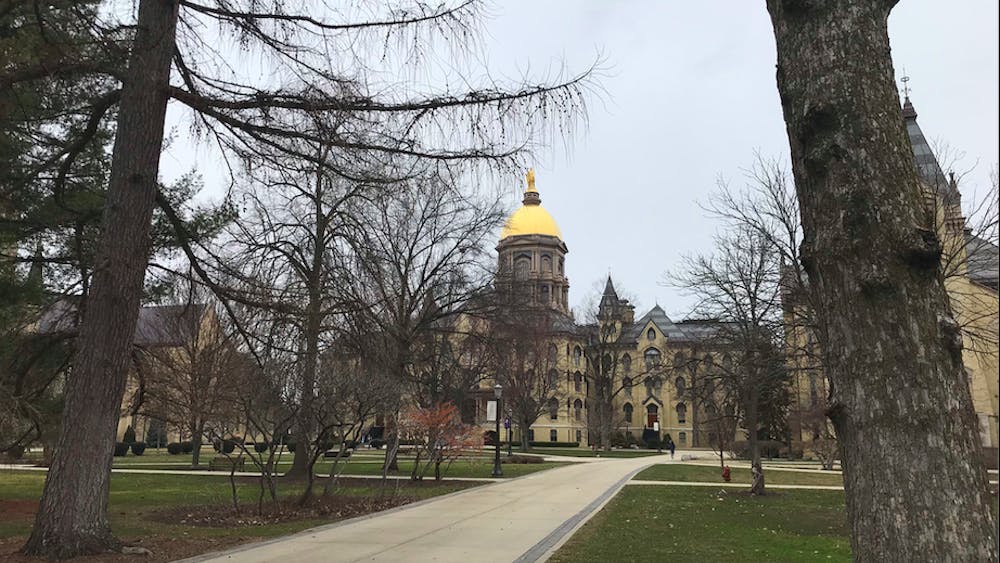“Venite ad me omnes” — “Come to me all of you,” reads the base of the Sacred Heart of Jesus statue on God Quad. The statue extends its arms toward Main Building, a symbol of our multicultural family.
Yet, despite Notre Dame’s commitment to diversity and inclusion, our student body is visibly homogenous. With this in mind, it is imperative we consider the obstacles to diversity that exist within the Notre Dame admissions system: namely, our university’s preferential admission policy for children of alumni.
Full disclosure, I am a legacy student. And while I realize I may be the last person critics of legacies want to hear from, I hope my voice as a beneficiary and a critic helps prompt closer inspection of a backward policy undermining our university’s mission.
Notre Dame leads top U.S. colleges in legacy admissions. Of our freshman class, children of alumni comprise 21.3%. In comparison at Harvard, the subjectofrebuke on legacy admissions, children of alumni comprise 14.6% of the freshman class.
Correspondingly, Notre Dame struggles with racial and socioeconomic diversity. Just 35% of Notre Dame students are people of color; comparable CatholicandMidwesternuniversities all exceed that figure. Additionally, Notre Dame students are less likely to have family income in the bottom fifth — and more likely to have family income in the top fifth — than students at these universities.
The connection is clear. Our alumni base is less racially diverse than our student body, and Notre Dame alumni tend to have higher incomes. Children of alumni typically reflect these whiter, wealthier backgrounds.
Prioritizing whiter, wealthier applicants places further barriers to the social advancement of marginalized groups. It also undermines the sort of campus discourse that “requires, and is enriched by, the presence and voices of diverse scholars and students.”
Some credit Notre Dame’s high legacy numbers to the quality of legacy applicants, not preferential admissions policies. Don Bishop, associate vice president for undergraduate enrollment, argues legacy applicants fare better because they come from “better-educated households” that “tend to be more economically successful” and “promote academics and achievement more than most households.” Additionally, Bishop cites the higher birth rates of Catholic families: “If we’re double the Ivies, it’s because we have more kids.”
Yet those kinds of practiced answers feel evasive. Notre Dame is not legacy blind. As a 2014 Notre Dame Magazine article describes, the university has a “commitment made some years back to maintain a legacy presence of 20 to 25% of the student body.” In fact the legacy bump is so large, Bishop tells the magazine, “there are about 1,000 kids walking this campus today who are alumni kids who, if we did not have this commitment to the alumni, would not be here — about 250 per class.” At a university struggling with racial and socioeconomic diversity, this legacy admissions quota is indefensible.
The best solution here would be to remove legacy preference. Johns Hopkins did so in 2014, and as their share of legacy students dropped, their share of students eligible for Pell Grants more than doubled. As for the supposed hit to alumni donations, a study of American universities between 1998 and 2008 found “no statistically significant evidence of a causal relationship between legacy preference policies and total alumni giving among top universities.”
Yet, if we must keep our legacy admissions quota, another solution might be to set comparable benchmarks for diversity. In our Class of 2023, 31% of American students are people of color. In future classes, this figure should better reflect the percent of Catholic Americans that are people of color: as of 2014, 41% and rising. For socioeconomic diversity, one good benchmark might be Johns Hopkins’ 10 percentage point jump in Pell-eligible students post-2014. In the Notre Dame Class of 2023, 11.1% of students receive Pell Grants; to offset legacy admissions, this figure should move toward 15-20% in future classes.
In any case, this issue does not come down to a statistical debate. Rather, it comes down to a question: does Notre Dame have the same commitment to diversity that it does to children of alumni? Doing away with legacy preference would send that message. So too might strong movement toward these diversity benchmarks, or even a different path altogether. There is a healthy discussion to be had here. But first, we must determine that the question at issue is one worth asking.
It’s time to rethink legacy admissions
The views expressed in this column are those of the author and not necessarily those of The Observer.









